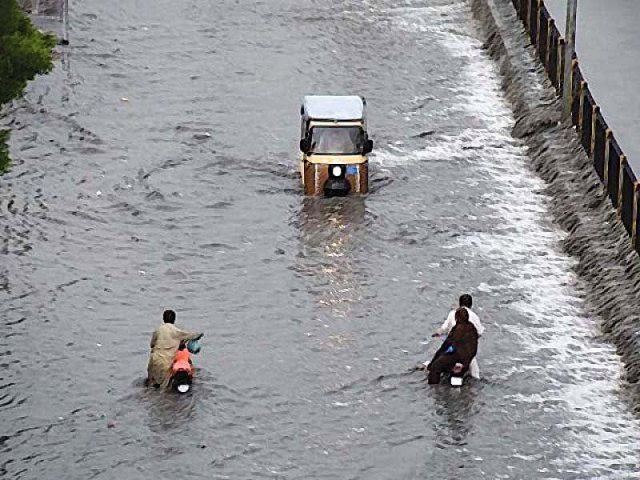Flood safety project awaits Rs96b
Successive govts failed to earmark funds for protection walls, warning systems

Successive governments have failed to find a Rs96 billion fiscal space for a flood protection project, which had been designed in 2015 to erect protection walls and install early warning systems, contributing to the recent catastrophe owing to misplaced priorities.
Though the governments of Pakistan Muslim League-Nawaz (PML-N) and Pakistan Tehreek-e-Insaf (PTI) could not provide Rs96 billion in budget over the past many years, they have allocated a whopping Rs157 billion for the schemes of parliamentarians since June last year. Official documents placed before the Central Development Working Party (CDWP) meeting a day earlier speak volumes about the insensitivity of successive governments towards the protection of lives and people’s belongings from floods despite serious risks posed by climate change.
The Ministry of Water Resources and the Federal Flood Commission (FFC) prepared the Flood Protection Sector Project (FPSP)-III under the umbrella of National Flood Protection Plan-IV (NFPP-IV), according to the documents.
After the super floods of 2010, the FFC started formulating the National Flood Protection Plan-IV. It hired a consultant in May 2013 that submitted a draft plan in 2015.
It took the Council of Common Interests – the constitutional body set up to deal with federal and provincial issues – another two years to approve the national plan.
CDWP on Wednesday reviewed the status of the project, which in the past had been put before it at last three times. But the project is still not ready to be executed.
The meeting was informed that the scheme would be added to next fiscal year’s Public Sector Development Programme (PSDP), as there was a lack of clarity on funding by foreign lenders and the earlier plan also needed changes in light of the recent floods.
Read Flood losses may cross $40b
The floods have affected over 33 million people, taken more than 1,350 lives and caused damages that, according to Planning Minister Ahsan Iqbal, could be as high as $40 billion.
The “scope of work and cost of the project may be changed that is to be identified through damage assessment and need assessment by all stakeholders and implementing agencies”, the meeting was informed by the water resources ministry. It added that PC-I was prepared two years ago, therefore, the assessment of proposed interventions needed to be conducted by the FFC and the ministry.
“Financing plan is not clear in the PC-I. It should be clarified that how much cost in total to be borne by PSDP, donor and respective province,” the Planning Commission said in comments that describe current status of the project that has been under consideration since May 2015.
The position paper showed that out of Rs96 billion, an amount of Rs76 billion had been planned to be spent on flood protection works.
Another Rs20 billion was meant for the installation of early warning systems, weather radars, provision of glacier monitoring system, automatic weather stations and installation of 196 telemetry stations across four provinces, Gilgit-Baltistan and other areas.
CDWP was informed that the federal government would provide Rs29.2 billion and the Asian Development Bank (ADB) might provide a foreign currency loan equal to Rs67 billion. The last PTI government had allocated Rs68 billion for the parliamentarians’ schemes. The new coalition government has also allocated Rs70 billion for the same purpose in the budget and recently diverted Rs23 billion more towards 47 projects, recommended by the coalition partners.
In May 2013, the FFC engaged Nespak through the World Bank-funded Water Sector Capacity Building and Advisory Services Project (WCAP) for the preparation of NFPP-IV for the next 10 years. The draft final version of NFPP-IV was submitted by consultants to FFC in May 2015.
Documents showed that in May 2017, the CCI approved “the final draft version of NFPP-IV costing Rs332.2 billion”. But “the umbrella PC-I of NFPP-IV could not be approved due to financial constraints”, revealed the documents.
To address the fiscal constraints, the government came up with a plan of starting only “priority projects” under the Flood Protection Sector Project of Rs96 billion.
Major objectives of the project are “reduction in flood losses to private and public infrastructure in an economically sound manner, protecting urban and rural population, agricultural land besides vital infrastructure installations, up-gradation of existing flood forecasting and warning facilities for better flood forecasting”, showed the documents. Despite this, the successive governments could not find Rs96 billion fiscal space over the past many years.
Read more Met Department blamed for flood disaster
Documents showed that the CDWP considered the project on October 12, 2020 and approved the umbrella PC-I at an estimated cost of Rs96 billion for negotiations with donors with some directions.
Again a position paper was considered by the CDWP on February 1, 2021 and it directed the EAD to coordinate with the ADB and come up with a draft commitment for financing in the next CDWP meeting.
The position paper was again considered by the CDWP on February 8, 2021. Lately, Prime Minister Shehbaz Sharif directed that the federal government in consultation with provincial governments shall conduct the flood damage and need assessment for rehabilitation and reconstruction and also to update the National Flood Protection Plan-IV to include flood protection measures against flash floods and hill torrents in the plan.
Published in The Express Tribune, September 16th, 2022.
Like Business on Facebook, follow @TribuneBiz on Twitter to stay informed and join in the conversation.



















COMMENTS
Comments are moderated and generally will be posted if they are on-topic and not abusive.
For more information, please see our Comments FAQ